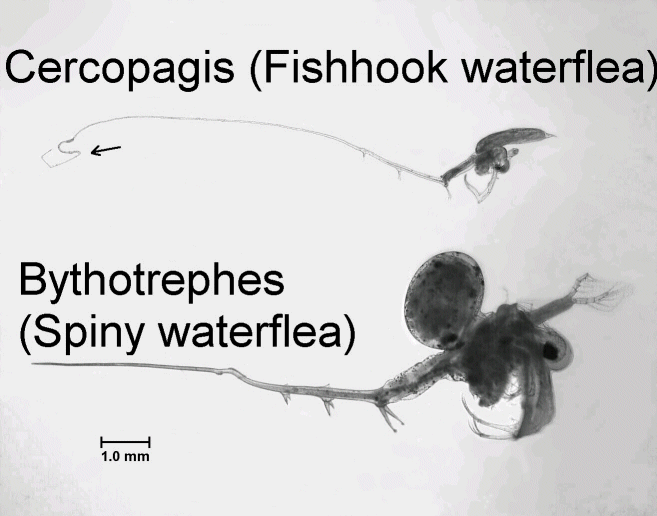
Spiny water fleas (Bythotrephes longimanus) are crustaceans, the same group of animals that includes crabs, shrimp, crayfish and lobsters. However, unlike these other crustaceans, spiny water fleas are known as zooplankton– small animals that rely on water currents and wind to move long distances. Also called Bythotrephes (Byth-o-TREH-feez), spiny water fleas are much larger than most zooplankton species in the United States; including its spine, the spiny water flea is approximately 1 cm (0.4 inches) in length.
This invader can be identified by its unique body shape, which consists of a hard outer shell and long, barbed tail spine. The spine makes up over 70 percent of the animal’s total length and it contains from one to four pairs of thorn-like barbs. The head consists primarily of a single, large eye filled with black pigment and a pair of mandibles, or jaws. The animals possess four pairs of legs, the first pair being much longer than the others.
Although small, the spiny water flea can have a profound effect on waterbodies.
The organism is native to Northern Europe, but has since invaded the United States and Canada. It was first discovered in Lake Huron in 1984 and likely introduced through the ballast water of ocean going ships. Since then, populations have exploded. Today the spiny water flea is found in all of the Great Lakes and has begun to invade smaller inland waters of the Great Lake states and Canada. See the current distribution of spiny water flea in the United States.
Female spiny water fleas can produce up to 10 offspring every two weeks during the summer months.
These crustaceans reproduce rapidly. During the summer months, the spiny water flea will reproduce through parthenogenesis. This asexual mode of reproduction allows female spiny water fleas to produce up to ten eggs that develop into genetic replicas of the mother. At optimum temperatures, parthenogenesis produces a new generation of females in less than two weeks. As temperatures drop in the fall, eggs are produced that become dormant and can survive through the winter on lake bottoms. These eggs can be transported long distances on boats or equipment, if they stay moist, allowing a new generation to hatch and invade new habitats in the spring.
The main diet of spiny water fleas is other zooplankton. Spiny water flea introductions result in an average 30 to 40 percent decline in native populations of zooplankton. This can lead to less food that has lower nutritional value for small native fish and the young of sport fish such as bass, walleye and yellow perch. The spiny water flea is often inedible by fish, as its long spines make them both difficult to consume and digest. As a result, the more abundant spiny water fleas become, the less food available for fish.
Researchers believe that spiny water fleas are the greatest threat to the biodiversity and structure of native zooplankton communities on the Canadian Shield since acid rain.
In addition, spiny water flea can impact recreational angling and commercial fishing. Their tail spines may become entangled in fishing equipment, making it difficult to reel in lines and clogging nets and trawl lines.
Spiny water fleas and their eggs are easily transported in the standing water of boats and bait buckets. Furthermore, fishing lines and down-riggers used in infested lakes can become coated with both eggs and adults which can be transported if the gear is not cleaned before it is used in a different lake. While spiny water fleas will die out of water (after several hours), they produce eggs that are resistant to drying and freezing. If moved into a new waterbody, the eggs can hatch and quickly multiply into a large population.
There are no known controls for spiny water flea once they are introduced to a lake, which is why prevention is key.
To date, the only effective strategy for controlling spiny water flea is to prevent its introduction into new bodies of water.